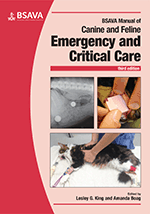
Full text loading...

This chapter covers all of the vital stages of emergency evaluation in the critically ill patient: telephone triage; waiting room triage; primary survey and initial treatment; and secondary survey and the emergency plan. The chapter highlights methods for blood sampling and analysis, acid-base and electrolyte monitoring and cage-side ultrasonography.
Triage of the emergency patient, Page 1 of 1
< Previous page | Next page > /docserver/preview/fulltext/10.22233/9781910443262/9781910443262.1-1.gif

Full text loading...



